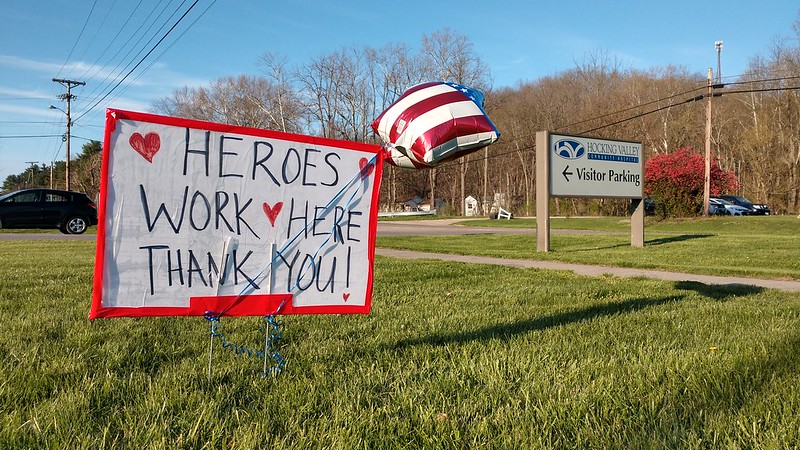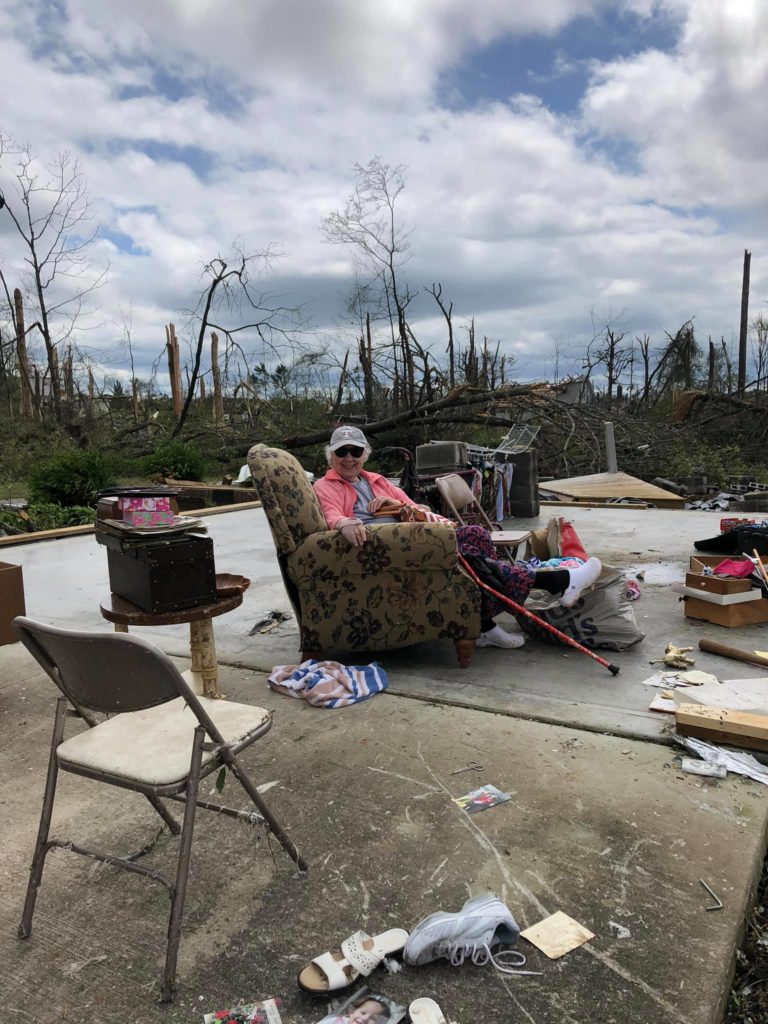Revised Common Lectionary Reflection, Third Sunday of Easter, Year A
April 26, 2020
Lessons: Acts 2:14a, 36-41; Psalm 116:1-4, 12-19; 1 Peter 1:17-23; Luke 24:13-35
Theme: God’s faithful and generous people learn to look for (and see) Jesus in places both expected and unexpected.
Key Scripture: When he [Jesus] was at the table with them, he took bread, blessed and broke it, and gave it to them. Then their eyes were opened, and they recognized him; and he vanished from their sight. – Luke 24:30-31
Being broken is both terrifying and beautiful. Think about for a minute. All of us experience brokenness in varied ways. Whether we’re talking about broken dreams, broken systems, broken lives, broken promises, broken health, broken hearts, or even broken bread, it all comes back to our capacity to experience the discomfort of brokenness. Some broken things we can fix easily, while other kinds of brokenness may not be “fixed” in this life. To complicate matters, human beings don’t necessarily agree with exactly what’s broken or how to fix it. We increasingly even have a hard time agreeing on what we’re seeing!

This week’s gospel lesson speaks volumes about both brokenness and sight. Because of our own present global situation, this lesson has much to teach us, along with some very good news. The two disciples on the road to Emmaus are broken. They share their story, their grief, and their confusion with the stranger on the road, but they have no clue they are speaking with Jesus. It isn’t until another breaking that they recognized his presence among them. Something in the way Jesus breaks the bread opened their eyes to see, yet only for a second. That bit of breaking was enough, however, to set them on the road back to Jerusalem to share this amazing news, to break it open so to speak.
Sight and what we see are keys to this lesson. Perhaps what we don’t see is more to the point. How often do we miss evidence of the Christ at work in our world right now? And when is it that we see most clearly? Not in the midst of overstuffed schedules and harried days. Probably not often in the times when life is just rolling along like a lazy lovely river. We see most clearly on either end of the “vision” spectrum: in times of awe, wonder, and joy, and in times of great brokenness, sorrow, and pain. Yes, it’s when the very ordinariness, predictability, and comfort of life is shattered that we are truly able to see and understand. Like the Jesus sighting of Cleopas and his buddy, it takes an awareness of just what has been broken for them to recognize Jesus. On the road they are so focused on their own broken dreams and hopes that they can’t see the risen Christ right before their very eyes—even though they are telling him the story of his own crucifixion. It takes seeing him in the ordinary hospitality of community, the breaking of bread, for them to recognize the presence of divine love.

Many of us are experiencing a time of brokenness right now. Life as we knew it changed drastically because of a microscopic virus. Thanks to COVID-19 we have seen examples of the best and worst humankind has to offer. Everything from fear to bravado is on display, not that those two words are so far apart. Our vision has also been shaken up. Now is the time, in the midst of our present brokenness, to look around for signs of Jesus in the world. I guarantee you will find him in both ordinary and extraordinary places, in ordinary acts of hospitality and grace (think bread, wine, and water), and wherever suffering, pain, confusion, and lack of hope have stripped the blinders away. There’s where you’ll find evidence of the Christ writ large, of cosmic proportions. Just look. Pay attention. Be amazed.
In Worship
Consider sharing stories of where worshipers have seen Jesus at work in the world. If you are worshiping digitally, invite folks to send short video clips or to post video clips to your Facebook page or group. Make sure your music, hymnody, and visual elements support the themes of seeing, vision, and blessed brokenness. Don’t be concerned about rough cuts and lack of editing. These stories have a life of their own thanks to the Holy Spirit. I’ll share the one that caused me to see clearly this week.

One of my childhood friends lost her home and her mother’s home nearby in a post Easter tornado. Both structures were completely broken and scattered like Legos. My friend and her husband both suffered near misses as their house collapsed around them, but they were spared. Her mother’s house was reduced to a concrete slab, nothing left standing. Emergency workers later found her mother alive, still in her recliner about twenty yards away, buried beneath debris, her only injuries a few broken fingers. Her mother reported to family members that she’d had a conversation with God as her home began to break apart around her, saying “Lord you promised to never leave me nor forsake me, NOW come & get me!”
If that’s not a glimpse of Jesus in the world, we’d better all give our lenses a good cleaning. The good thing about stories is that once folks start sharing them, the Holy Spirit seems to have a way of generating more.
With Youth
This is a good week for check in. If you can, begin some conversation about how our current Road to Quarantine situation may be similar to the Road to Emmaus story in this week’s gospel. Invite youth to share what they are seeing, hearing, and experiencing. Where have they seen God at work? Where has Jesus clearly been present? Where do you wish you had seen Jesus?
You might also want to invite youth to share their favorite songs for a time of quarantining and sheltering. Consider putting together a playlist on Spotify or other streaming service to share.
With
Children
This week’s focus verses are Luke 24:30-31 – When Jesus was
at the table with them, he took bread, blessed and broke it, and gave it to
them. Then their eyes were opened, and they recognized him; and he vanished
from their sight.
Have you ever seen something and then wondered whether you’d really seen what you were sure you saw? Maybe it was a dolphin jumping out of the water along the shoreline, or perhaps a triple rainbow as you’re barreling down the highway. You ask, “Did I just see what I thought I saw?” So you’re not quite sure. Maybe you were focused on something else or not paying full attention. But there it is again. You look and you see it, and then it’s gone again. But you begin to formulate the vision of what you saw in your mind and maybe even in your heart. You remember how your heart thrilled with the sight of the sleek and graceful dolphin. You are able to count the rainbow’s colors clearly, seeing them with your eyes closed. You know you saw it, and you are so excited that you want to share this news with others because it’s so cool, so amazing.
That must have been what it was like for Cleopas and his friends. Jesus was right there beside them the whole time, but they don’t really see him until he breaks the bread at supper, and they remember in that act of hospitality who he really was. Even though seeing Jesus is just a brief blip of sight, it is enough to make them want to share this really good news with others, and off they went.
I don’t know about you, but good news would be helpful right now. I have a question for you. Where have you seen Jesus at work in the world this week? (Entertain all answers, and help the children tease out their stories if you’re meeting via Zoom. If you are not meeting live, share a story or two of where you have seen Jesus this week, and invite them to share stories in their homes and with their friends and family when they talk or Facetime.
Finish with a simple echo prayer and blessing.
Dear God (Dear God),
Thank you for loving us (thank you for loving us). Thank you for Jesus (Thank you for Jesus). Help us to look for you (Help us to look for you) wherever we are (wherever we are) and wherever we go (and wherever we go). Help us to see clearly (Help us to see clearly) so that we can tell others (so that we can tell others). Keep us from fear (Keep us from fear). Keep us hopeful (Keep us hopeful). Make us helpful (Make us helpful). Give us peace (Give us peace). Amen (Amen).
Weekly Stewardship Bulletin Insert
Thank you for continuing to be good stewards during these uncertain and anxious times. Because of your faithful support as you have been able, we are able to continue ministry and share God’s love with our world. Thank you for your patience and for caring about and loving your neighbors. Thank you for seeing the importance of and need for love and hope in this time.
Stewardship
at Home
Let’s make this a week of cultivating clear vision. We’ve
certainly seen a lot of brokenness, fear, anger, anxiety, and irritation as the
weeks of COVID-19 restrictions wear on. If you have access to the Web, look up
some images of people in this time. Try to get a variety of sources for this
prayerful exercise. Look for images from the recent reopen protests, from
healthcare workers, from essential business employees. Once you collect several
photos, begin to pray over them, asking God to help you see clearly each person’s
humanity, to see them as you see them.
As you look at each image try to see what emotions and concerns might be driving the person in the photo. What similarities might you share with them? What differences? What do you think Jesus sees when he looks at this person or people? Pray to see all people and situations through the divine eyes of love, mercy, and grace. By the way, don’t forget to extend that same love, mercy, and grace to yourself, too.
If we can come through this time with clearer vision, with more love, empathy, mercy, and kindness, we will truly have begun to surpass what this virus or anything else can do to divide us. Love always wins.
2017 Reflection: https://www.stewardshipoflife.org/2017/04/rearview-mirror-stewardship/
2011 Reflection: https://www.stewardshipoflife.org/2011/05/addressing-%e2%80%9cpast-tense-hope%e2%80%9d-syndrome/
Images: Mike Moyers, https://www.mikemoyersfineart.com/, The Real U.S> Navy Page, and Dan Keck, Creative Commons usage license. Thanks!
Note: Reprint rights granted to congregations and other church organizations for local, nonprofit use. Just include this note: “Copyright (c) 2020, Rev. Sharron Blezard. Used by Permission.” Other uses, please inquire: thewritelife@hotmail.com.




Leave a Reply